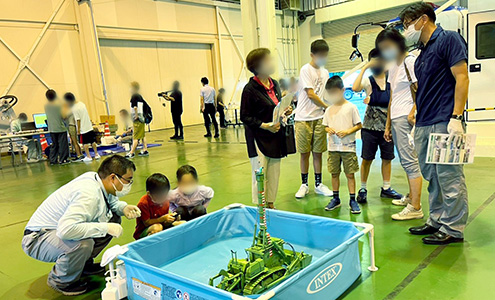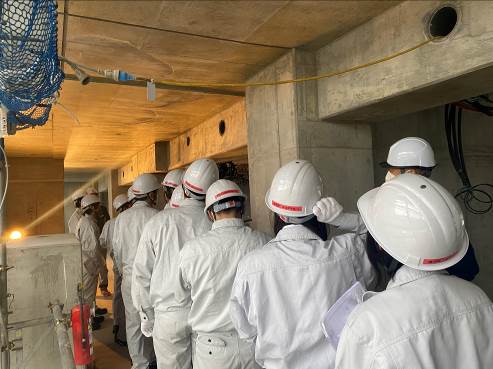Buildings with 15% more earthquake resistance than prescribed by the Building Standards Act
Japan is a country with many earthquakes, to the extent that an estimated 20% of all earthquakes of magnitude 6.0 or higher worldwide occur in or around Japan. In light of that, we endeavor to construct earthquake-resistant buildings in Japan, guided by the conviction of Takamatsu Corporation, the Group's founding company, of carefully building highly finished buildings from a long-term perspective.
Zero damage from the Great Hanshin-Awaji Earthquake of 1995
Our solution to providing even further safety and peace of mind: Go 15% beyond the Building Standards Act

Condominium built by Takamatsu Corporation during the Great Hanshin-Awaji Earthquake
Although 108 Takamatsu-built condominiums were located in the most severely hit areas, which suffered tremors of Intensity 6.0-7.0 during the Great Hanshin-Awaji Earthquake of 1995, none of them suffered any structural damage, with the damage being limited to a crack in the emergency staircase in a single building. The resilience of our company's buildings in contrast to the many surrounding buildings that collapsed greatly improved our reputation and markedly accelerated the Group's growth. We then conducted further in-house verification tests to figure out how to construct even safer buildings affording greater peace of mind. Our conclusion was that approximately 15% of extra strength is needed when vertical shaking is considered in addition to the horizontal shaking which is the only thing stipulated by the Building Standards Act. "15% over the Building Standards Act" thus became the standard for Takamatsu Corporation.
Earthquake-resistant construction is construction designed to apply the force of the earthquake as an external force and resist it with the structural materials of the building, instead of reducing the force with seismic isolation devices or absorbing it with vibration control devices.

Takamatsu Corporation standard pillar

Building Standards Act pillar
The Building Standards Act mandates that buildings must not collapse or be destroyed even if a powerful earthquake of the kind that only occurs once every few centuries (over Intensity 6.0 - 7.0) should occur. That is known as Seismic Grade 1. At Takamatsu Corporation, in addition to ensuring adequate safety, from financial and other perspectives, as a standard we design structures to have 1.15 times the earthquake strength compared to the Building Standards Act. We can also meet the requirements for Seismic Grades 2 and 3 in response to various conditions and requests.
Fostering the next generation
Asunaro Aoki Construction Co.,Ltd. participated in the Children's Summer Holiday Experience Class 2022
On July 26th, Asunaro Aoki Construction Co.,Ltd. participated in the Children's Summer Holiday Experience Class 2022 organized by the Kanto Technical Office of the Kanto Regional Development Bureau of the Ministry of Land, Infrastructure, Transport and Tourism (located in Matsudo, Chiba).
The event allowed children in elementary and junior high school to experience construction technology and featured a range of experiences such as building an arch bridge, working with cement, compacting earth, remotely operating construction machinery and riding on disaster response vehicles. Asunaro Aoki Construction's exhibition was an experience operating an amphibious bulldozer via radio control.
On the day of the event, we took sufficient precautions against COVID-19 such as wearing masks and assisting with alcohol sanitization. Through the radio control operation experience, we were able to spark an interest in construction work and in our company's technology in many school children and their parents and guardians.

The amphibious bulldozer radio control operation experience 1

The amphibious bulldozer radio control operation experience 2

Radio controlled model amphibious bulldozer

Picture books about the amphibious bulldozer's achievements
Asunaro Aoki Construction Co.,Ltd. organized a construction site tour for high school students
On November 7th, Asunaro Aoki Construction Co.,Ltd. invited 39 first-year students in the Construction department of Yokosuka Technical Senior High School for a tour of the construction site of Honkugo Improvement Apartments, located in Yokosuka, Kanagawa.
During the event, the deputy site foreman gave a summary of the construction process from framework to finishing, and taught the attendees about the series of processes involved in this project. They then moved to the building under construction on a long span elevator for a tour. Students commented that they were impressed at the closeup perspective of a building being constructed from the ground up, and that being able to see a real construction site was a positive experience for them. The site tour served as a good opportunity to heighten their interest in construction work.

Explanation of signs and displays

Touring the construction site

Question and answer session

External perspective image (bird's-eye view)
Takamatsu Corporation Co., Ltd. organized the Construction Expedition 2022 Summer Holiday Series
On August 3rd 2022, Takamatsu Corporation Co., Ltd. hosted the Construction Expedition 2022 Summer Holiday Series organized by the Japan Federation of Construction Contractors (Nikkenren) as a special summer holiday program at the site of the "Sengoku India International School New Campus Construction Project" currently under way in Koto-ku, Tokyo.
The tour was an event planned mainly for children in elementary and junior high school and their parents and guardians. It involved work experiences and a tour of the normally inaccessible construction site, with the aim of teaching them the details and appeal of construction work. The event was originally named the "Construction Beauty Activity Site Tour" and organized as a tour for girls in elementary and junior high school to see women playing active roles on construction sites. In 2022, however, it was renamed to the "Construction Expedition" and included both girls and boys without limitation. After its suspension in 2020 and 2021 due to the coronavirus crisis, 2022 marked the first time the event had been held in three years.
On the day of the event, 10 groups of 24 children and their guardians participated, exploring the actual construction site of a familiar concept like a school building and a gymnasium. To make construction feel even more personal and familiar, they also saw a giant mobile crane up close and compared their heights to it. They also had fun with water after making water guns out of the PVC pipes used for construction. Afterwards a question and answer session was held, and the workers at the site answered the children's questions.

We believe the establishment of an environment where employees with diverse skills and personalities can fulfill their potential is essential for realizing our business strategy.
By taking on the challenge of becoming a Leading Company, we will realize an organization in which employees can experience the joy of working and growth, and maintain and attract excellent human resources. We will focus on creating a corporate culture where employees engage in work with pride and satisfaction, and maintain high performance.
Promotion of Diversity
Women's participation is a critical issue as the construction industry faces the concerns of labor shortage due to the aging population and falling birth rate. In addition to securing human resources, there are high expectations for input from women in the areas of design and interior, as well as on safety and comfort. TCG Group has many female employees, mainly in design departments. More recently, the number of women working at construction sites is increasing, with 34 and 23 mainly younger-generation female employees working at construction sites for Takamatsu Corporation and Asunaro Aoki Construction, respectively.
Organizational Support towards Diversified Workstyle
1)Childcare Leave
2)Employment during Child Care Period
·Shortened Woktime
Under Child Care and Family Care Leave Act, employees who nurture children under 3 years old are allowed to shorten standard working hours. In Takamatsu Construction Group, we set up a shortened worktime until the end of third grade of elementary school, which exceeds the statutory requirement.
·Exemption of Overtime Work
·Restriction of Overtime Work
·Restriction of Midnight Work
3)Child Nursing Vacation
4)Maternity Health Care Measures during Pregnancy, etc.
5)Nursing Care Leave
6)Worktime during Nurse Care Period
·Shortened Woktime
·Exemption of Overtime Work
·Restriction of Overtime Work
·Restriction of Midnight Work
7)Nurse Care Leave
Initiatives to Promote Female Participation
1)Expansion of Female Work Area (Construction Sites, Sales, etc.)
2)Active Recruitment of Female Workforce
3)Appointment of Female Manager
4)Female Training Programs
FY2016: Female Manager Training
FY2017: Training for Mid-career Female Employees
FY2018: Female Career Design Training
5)Training for Managers with Female Subordinates
6)Reduction of Prescribed Working Hours
7)Promotion of Taking Annual Paid Leave
8)Introduction of Half-day Paid Leave System
Formation of a Socially Meaningful Corporate Group
Cultural Property Preservation and Protection Business
Takamatsu Construction Group is proud to be one of the few construction companies in Japan that have achieved significant growth through M&A. Takamatsu Construction Group is a corporate group comprised of 20 companies, of which there are socially meaningful group companies that joined our Group through M&A. One set of companies in our Group is Kongo Gumi Co.,Ltd., Nakamura Shaji Co.,Ltd. and Shimada Gumi Co.,Ltd., that contribute in a very unique way to the preservation and protection of Japanese cultural properties.
Kongo Gumi : The Company with Longest History in the World

"Chon-na Hajime" Ceremony
(Start of the Hand Axe Ceremony, privately held)
Kongo Gumi Co.,Ltd., which joined our Group in 2005, is said to be the oldest company in the world. Kongo Gumi is a shrines and temples architecture company with its history of more than 1440 years since Shigemitsu Kongo became the first president in 578A.D. as the "Sei-daiku", a carpenter in charge of protection of Shiten-no-ji temple built by Shotoku Taishi. Throughout its long history, the Kongo Gumi has consistently dealt in architecture of shrines and temples.
Although shrines and temples architecture technology has its origin deriving from China and Korea, as it passed through generations it developed into a traditional technology and culture that Japan can take pride of over a long period of time. The core portion of the technology and tradition was maintained and developed for many years by shrines and temples architecture organizations, with Kongo Gumi having an exceptionally long history and rich know-how. The core portion of know-how that Kongo Gumi maintained for a long time lies in apprentice organization where the carpenters who are involved in the construction and repair of shrines and temples passed down their know-how from generation to generation.
The expertise that Kongo Gumi inherited over the years is not limited to organization and technology but also various and unique cultural events. One of the events is "Chon-na Hajime" Ceremony (Start of the Hand Axe Ceremony). It is a traditional ceremony in which shrine carpenters mark the beginning of work for the year. Taking part in the "Chon-na Hajime" ceremony is a great honor for shrine carpenters, whereby as for generations the head of the Kongo family has taken on the duty of joining this traditional and solemn performance every year as the primary carpenter of Shiten-no-ji. The tradition continues to this day.
Although contributing to the Japanese culture with its unique organization, Kongo Gumi has suffered and overcome numerous crisis of generation breakdown that were triggered by wars, natural disasters and management crises. One of the biggest breakdown crises took place in 2005, when Kongo Gumi stepped into reinforced concrete architectures and ran into deep financial crisis. In a desperate situation where their lawyers declared Kongo Gumi that their own recovery is impossible, Takayasu Takamatsu, then the Chairperson of Takamatsu Corporation said, "Its a shame of Osaka if Kongo Gumi goes bankrupt!" and took immediate action. On the other hand, he maintained a rational thinking that "Takamatsu Corporation can only invest to a project that can gain the understanding of our shareholders. Please immediately check whether Kongo Gumi is worth existing in the future or not." and decided to conduct management support and finally, Kongo Gumi joined Takamatsu Construction Group.
Kongo-Gumi Co., Ltd. cooperated with the Forestry Agency's Emergency Promotion Project for the Export of High Value-Added Wood
In November 2022, YouTubers Ryuuu TV, with over 1.8 million fans mainly in Taiwan, released a video entitled "神一樣的工匠!不用任何釘子能建築四天王寺?采訪世界最古老的企業金剛組" ("Godlike craftsmen! Can you build Shitennoji Temple without using any nails? A visit to the world's oldest enterprise, Kongo-Gumi.") This program was part of the Emergency Promotion Project for the Export of High Value-Added Wood run by Japan's Forestry Agency, and it was broadcast to convey the appeal of Japan-grown wood and products and buildings made from that wood to people in Taiwan in order to increase their desire to buy it. Filming took place from July to September 2022, during which the couple behind the Ryuuu TV YouTube channel toured Kongo-Gumi's Kansai machining center, learned about the appeal of Japanese wood and related traditions and technologies, and were introduced to the Japanese spirit of living together with wood and the skills honed over long years.
Nakamura Shaji Co.,Ltd : Founded 970A.D. (1st year of Tenroku)

Kuri (Storage) of Eihoji Temple
With its history of more than 1,100 years, Nakamura Shaji Co.,Ltd., which joined our Group in 2007, is said to be the eighth oldest company in the world. Nakamura Shaji also deals in architecture of shrines and temples. Since its foundation in 970A.D. when the first president was invited from Kyoto, the Company cultivated and passed on the skills and mindsets of traditional Japanese architecture as the group of Japanese traditional architecture professionals. Similar to Kongo Gumi, Nakamura Shaji plays an important role in our Group by possessing not only a long history but also an outstanding technology and track record resulting in top share of shrine and temple architecture of Aichi Prefecture.
Shimada Gumi Co., Ltd. : A Major Player of Excavation and Research of Buried Cultural Properties

Excavation and Research of Buried Cultural Properties
Shimada Gumi Co.,Ltd. that joined our Group in 2012, is a company dealing in excavation, research, analysis, relocation and maintenance of buried cultural properties, as well as development of historic sites. Shimada Gumi Co.,Ltd. records a top share in this field of business among the Japanese private companies. The preservation and investigation methods of buried cultural properties are stipulated by The Law for the Protection of Cultural Properties, and companies like Shimada Gumi need to conduct the excavation when these buried cultural properties were found, and to research buried cultural properties and investigate the cultures of ancient people.
Shimada-Gumi regularly holds "Local Explanatory Meeting" to disclose archaeological site information to provide opportunities to learn about the importance of buried cultural properties as well as local culture. At the Meeting, Shimada Gumi also exhibits discovered artifacts where many historical archaeology enthusiasts and local residents participate to listen eagerly to the comments of the researchers.
















